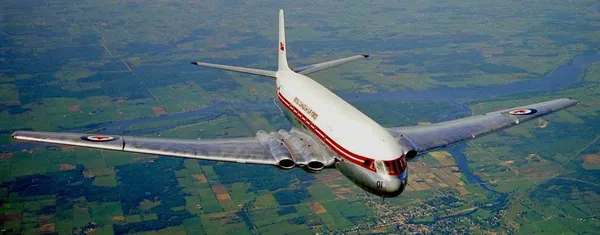de Havilland Comet

de Havilland DH.106 Comet, RCAF (Serial No. 5301).
The de Havilland DH.106 Comet was the world's first commercial jet airliner. Developed and manufactured by de Havilland at its Hatfield Aerodrome in Hertfordshire, United Kingdom, the Comet 1 prototype first flew in 1949. It featured an aerodynamically clean design with four de Havilland Ghost turbojet engines buried in the wing roots, a pressurised cabin, and large square windows. For the era, it offered a relatively quiet, comfortable passenger cabin and was commercially promising at its debut in 1952.
In March 1953, the RCAF received its first Comet. With the arrival of this aircraft, the RCAF became the first air force in the world to operate jet transports and the first operator to make scheduled trans-Atlantic Crossings.
However, within a year of entering airline service, problems started to emerge, with three Comets lost within twelve months in highly publicised accidents, after suffering catastrophic in-flight break-ups. Two of these were found to be caused by structural failure resulting from metal fatigue in the airframe, a phenomenon not fully understood at the time; the other was due to overstressing of the airframe during flight through severe weather. The Comet was withdrawn from service and extensively tested. Design and construction flaws, including improper riveting and dangerous concentrations of stress around some of the square windows, were ultimately identified. As a result, the Comet was extensively redesigned, with oval windows, structural reinforcements and other changes. Rival manufacturers meanwhile heeded the lessons learned from the Comet while developing their own aircraft.
Although sales never fully recovered, the improved Comet 2 and the prototype Comet 3 culminated in the redesigned Comet 4 series which debuted in 1958 and remained in commercial service until 1981. The Comet was also adapted for a variety of military roles such as VIP, medical and passenger transport, as well as surveillance; the last Comet 4, used as a research platform, made its final flight in 1997. The most extensive modification resulted in a specialised maritime patrol derivative, the Hawker Siddeley Nimrod, which remained in service with the Royal Air Force until 2011, over 60 years after the Comet's first flight. Wikipedia
 RCAF Comet Serials Histories - Kestrel Publications
RCAF Comet Serials Histories - Kestrel Publications
CASPIR Aircraft Groups:
RCAF On Strength (2)Comet 5301
1A / 1XB
Known Squadron Assignments:
Taken on strength on 26 February 1953. Used for crew training in the UK from March 1953. Delivered to RCAF Station Uplands on 29 May 1953. With No. 412 (T) Squadron at RCAF Station Rockcliffe, Ontario. To Paris and London on 13 October 1953. Grounded January 1954, following airliner crashes. Converted to Mk. 1XB with pressurization removed, back in service by September 1957. Visited Torbay, Newfoundland on 10 February 1958. Damaged when dinghy deployed in flight during compass swing over Uplands at 41,000 feet on 26 February 1958, holing fuselage. Visited Whitehorse, Yukon on 29/30 March 1958. Carried Minister of National Defence to 2 Wing at Grostenquin, France, April 1958. Carried Prince Bernhardt of Holland on Canadian tour, 8 May 1958. Delivered Governor General Vanier from Ottawa to Churchill, Manitoba on 11 June 1961. To Marville, France with AVM Cornblatt July 1961. Withdrawn from service in October 1963, stored at Mountain View, Ontario. Some parts used to rebuild Comet 5302 after both aircraft were sold. Rest scrapped in October 1964, except for nose which is now displayed in Canada Aviation Museum at Rockcliffe.last update: 2024-July-20
 RCAF Aircraft Record Card
RCAF Aircraft Record Card1953-February-21 First Flight first flight 2019-08-20
1953-February-26 Taken on Strength 2022-02-07
1965-July-30 Struck off Strength 2019-08-20
Comet 5302
1A / 1XB
Known Squadron Assignments:
Taken on strength on 26 February 1953, before first flight. Used for crew training in the UK from March 1953. Visited Johannesburg, via Rome, Cairo, Khartoum, Entebbe and Livingston in April 1953, on a training flight. Delivered to Canada 16 June 1953, via Keflavik and Goose Bay. With No. 412 (T) Squadron at RCAF Station Rockcliffe, Ontario. Grounded January 1954, following airliner crashes. Converted to Mk. 1XB with pressurization removed, back in service by September 1957. Flown as radar target during several training flights over Pinetree Line in January and February 1958. Carried Prime Minister Diefenbaker on Japan tour October 1961. Withdrawn from service in October 1963, stored at Mountain View, Ontario. Both Comets sold to one owner in 1963, who combined parts to build one airframe, registered as CF-SVR. Parked at Mount Hope (now Hamilton International) for several years while awaiting sale to Peru. Finally flown to Florida as N3735 in 1968. Scrapped in Florida c.1975.last update: 2024-July-20
 RCAF Aircraft Record Card
RCAF Aircraft Record Card1953-February-26 Taken on Strength 2022-02-07
1953-March-25 First Flight first flight 2019-08-20
1965-July-30 Struck off Strength 2019-08-20
PC — Ctrl-F
Mac — ⌘-F
Mobile —


 Comet Transport
Comet Transport Wikipedia Comet Transport
Wikipedia Comet Transport Harold A Skaarup Web Page
Harold A Skaarup Web Page